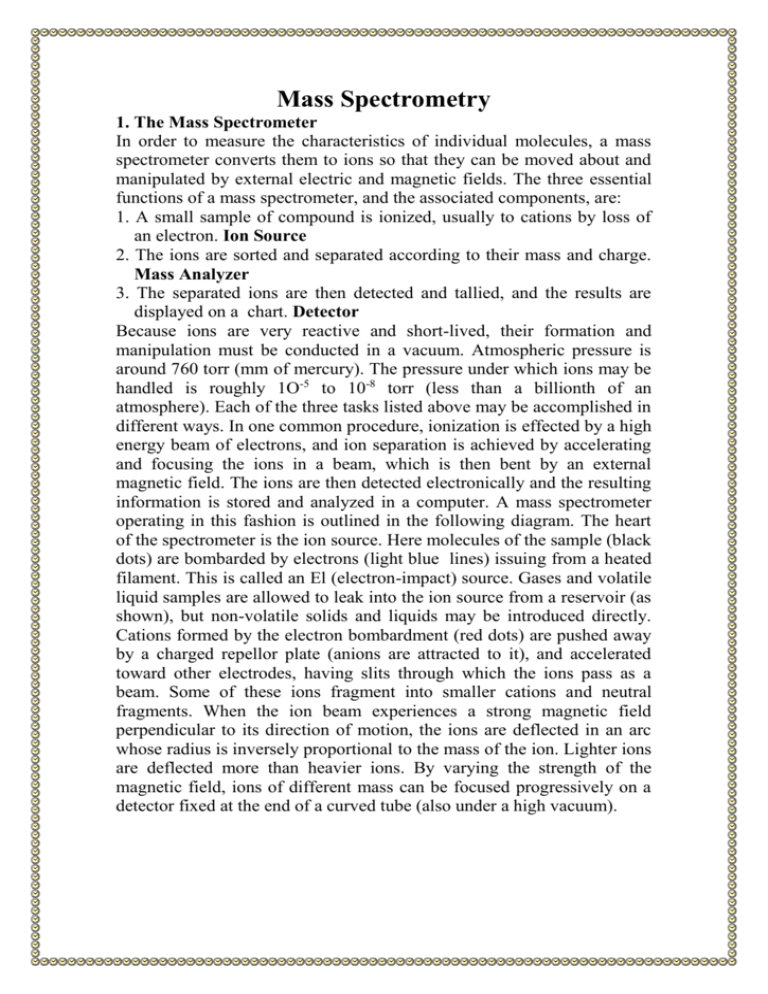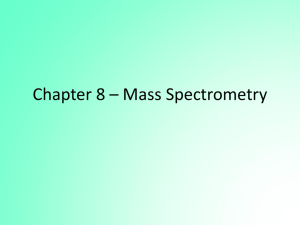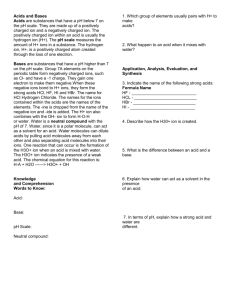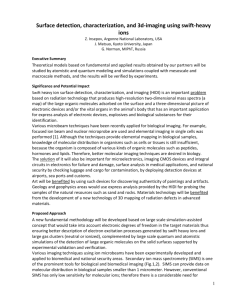pubdoc_3_15136_1577
advertisement

Mass Spectrometry
1. The Mass Spectrometer
In order to measure the characteristics of individual molecules, a mass
spectrometer converts them to ions so that they can be moved about and
manipulated by external electric and magnetic fields. The three essential
functions of a mass spectrometer, and the associated components, are:
1. A small sample of compound is ionized, usually to cations by loss of
an electron. Ion Source
2. The ions are sorted and separated according to their mass and charge.
Mass Analyzer
3. The separated ions are then detected and tallied, and the results are
displayed on a chart. Detector
Because ions are very reactive and short-lived, their formation and
manipulation must be conducted in a vacuum. Atmospheric pressure is
around 760 torr (mm of mercury). The pressure under which ions may be
handled is roughly 1O-5 to 10-8 torr (less than a billionth of an
atmosphere). Each of the three tasks listed above may be accomplished in
different ways. In one common procedure, ionization is effected by a high
energy beam of electrons, and ion separation is achieved by accelerating
and focusing the ions in a beam, which is then bent by an external
magnetic field. The ions are then detected electronically and the resulting
information is stored and analyzed in a computer. A mass spectrometer
operating in this fashion is outlined in the following diagram. The heart
of the spectrometer is the ion source. Here molecules of the sample (black
dots) are bombarded by electrons (light blue lines) issuing from a heated
filament. This is called an El (electron-impact) source. Gases and volatile
liquid samples are allowed to leak into the ion source from a reservoir (as
shown), but non-volatile solids and liquids may be introduced directly.
Cations formed by the electron bombardment (red dots) are pushed away
by a charged repellor plate (anions are attracted to it), and accelerated
toward other electrodes, having slits through which the ions pass as a
beam. Some of these ions fragment into smaller cations and neutral
fragments. When the ion beam experiences a strong magnetic field
perpendicular to its direction of motion, the ions are deflected in an arc
whose radius is inversely proportional to the mass of the ion. Lighter ions
are deflected more than heavier ions. By varying the strength of the
magnetic field, ions of different mass can be focused progressively on a
detector fixed at the end of a curved tube (also under a high vacuum).
When a high energy electron collides with a molecule it often ionizes it
by knocking away one of the molecular electrons (either bonding or nonbonding). This leaves behind a molecular ion (colored red in the
following diagram). Residual energy from the collision may cause the
molecular ion to fragment into neutral pieces (colored green) and smaller
fragment ions (colored pink and orange). The molecular ion is a radical
cation, but the fragment ions may either be radical cations (pink) or
carbocations (orange), depending on the nature of the neutral fragment.
An animated display of this ionization process will appear if you click on
the ion source of the mass spectrometer diagram.
2. The Nature of Mass Spectra
A mass spectrum will usually be presented as a vertical bar graph, in
which each bar represents an ion having a specific mass-to-charge ratio
(m/z) and the length of the bar indicates the relative abundance of the ion.
The most intense ion is assigned an abundance of 100, and it is referred to
as the base peak. Most of the ions formed in a mass spectrometer have a
single charge, so the m/z value is equivalent to mass itself. Modern mass
spectrometers easily distinguish (resolve) ions differing by only a single
atomic mass unit (amu), and thus provide completely accurate values for
the molecular mass of a compound. The highest-mass ion in a spectrum is
normally considered to be the molecular ion, and lower-mass ions are
fragments from the molecular ion, assuming the sample is a single pure
compound. The following diagram displays the mass spectra of three
simple gaseous compounds, carbon dioxide, propane and cyclopropane.
The molecules of these compounds are similar in size, CO2, and C3 H8,
both have a nominal mass of 44 amu, and C3 H6 has a mass of 42 amu.
The molecular ion is the strongest ion in the spectra of CO2 rand C3 H6,
and it is moderately strong in propane. The unit mass resolution is readily
apparent in these spectra (note the separation of ions having
m/z=39,40,41 and 42 in the cyclopropane spectrum). Even though these
compounds are very similar in size, it is a simple matter to identify them
from their individual mass spectra. By clicking on each spectrum in turn,
a partial fragmentation analysis and peak assignment will be displayed.
Even with simple compounds like these, it should be noted that it is rarely
possible to explain the origin of all the fragment ions in a spectrum. Also,
the structure of most fragment ions is seldom known with certainty.
Since a molecule of carbon dioxide is composed of only three atoms, its
mass spectrum is very simple. The molecular ion is also the base peak,
and the only fragment ions are CO (mlz=28) and O {mlz=16). The
molecular ion of propane also has mlz=44, but it is not the most abundant
ion in the spectrum. Cleavage of a carbon-carbon bond gives methyl and
ethyl fragments, one of which is a carbocation and the other a radical.
Both distributions are observed, but the larger ethyl cation (mlz=29) is the
most abundant, possibly because its size affords greater charge dispersal.
A similar bond cleavage in cyclopropane does not give two fragments, so
the molecular ion is stronger than in propane, and is in fact responsible
for the the base peak. Loss of a hydrogen atom, either before or after ring
opening, produces the stable allyl cation (m/z=41). The third strongest ion
in the spectrum has m/z=39 (C3H3). lts structure is uncertain, but two
possibilities are shown in the diagram. The small m/z=39 ion in propane
and the absence of a mlz=29 ion in cvclopropane are particularly
significant in distinguishing these hydrocarbons
3. lsotopes
Since a mass spectrometer separates and detects ions of slightly different
masses, it easily distinguishes different isotopes of a given element. This
is manifested most dramatically for compounds containing bromine and
chlorine, as illustrated by the following examples. Since molecules of
bromine have only two atoms, the spectrum on the left will come as a
surprise if a single atomic mass of 80 amu is assumed for Br. The five
peaks in this spectrum demonstrate clearly that natural bromine consists
of a nearly 50:50 mixture of isotopes having atomic masses of 79 and 81
amu respectively. Thus, the bromine molecule may be composed of two
79
Br atoms (mass 158 amu), two 81Br atoms (mass 162 amu) or the more
probable combination of 79Br-81Br (mass 160 amu). Fragmentation of Br2,
to a bromine cation then gives rise to equal sized ion peaks at 79 and 81
amu.
The center and right hand spectra show that chlorine is also composed of
two isotopes, the more abundant having a mass of 35 amu, and the minor
isotope a mass 37 amu. The precise isotopic composition of chlorine and
bromine is:
chlorine: 75.77%35Cl and 24.23%37Cl]
Bromine: 50.50% 79Br and +9.50% 81Br
The presence of chlorine or bromine in a molecule or ion is easily
detected by noticing the intensity ratios of ions differing by 2 amu. In the
case of methylene chloride, the molecular ion consists of three peaks at
m/z=84,86 & 88 amu, and their diminishing intensities may be calculated
from the natural abundances given above. Loss of a chlorine atom gives
two isotopic fragment ions at m/z=49 & 51amu, clearly incorporating a
single chlorine atom. Fluorine and iodine, by contrast, are monoisotopic,
having masses of 19amu and127 amu respectively.









